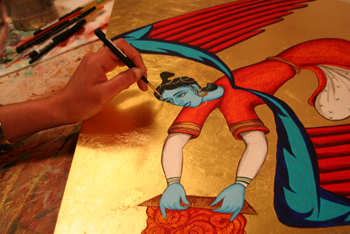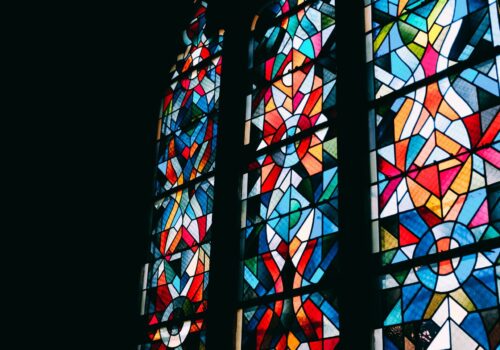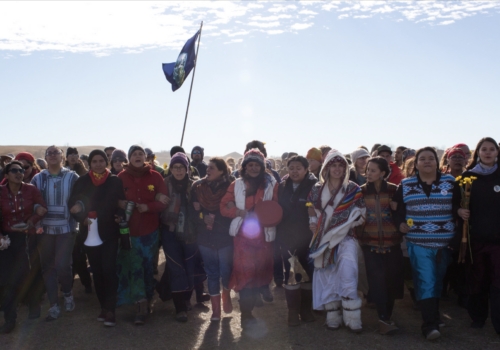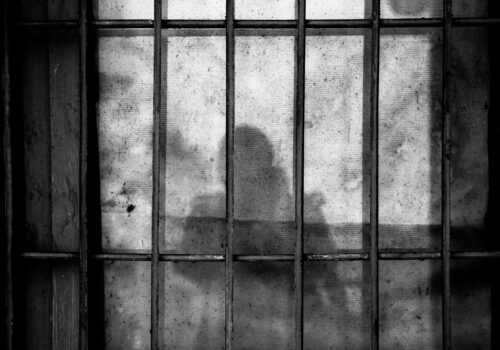About the Film
This twelve-minute documentary examines how the practice of the visual arts can involve the religious identities of young people. In this film, created for Practical Matters by independent documentary filmmaker Sonia Narang, an Indian Jewish visual artist works with a group of high school students at the SAR Academy, a modern Orthodox day school in New York City.
As artist-in-residence, Siona Benjamin is creating an exquisite Torah Ark for the school. She asks high school students to create their own artwork based on the prophet Ezekiel’s vision, from the first chapter of Ezekiel in the Hebrew Bible.
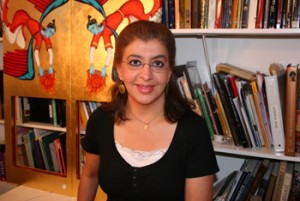
As the students create their own paintings and drawings and assist Benjamin with her Torah Ark, they reflect on Jewish identity, their personal aspirations, and why they consider it important to attend an all-Jewish school.
The artist, Siona Benjamin, is a Bombay-born Jew, a descendent of the centuries-old Bene Israel community in western India. Her work explicitly treats Jewish themes, and especially explores what it means to be a international Jewish woman of color. The school, SAR Academy, is a private Orthodox day school in the Bronx.
Visions of Ezekiel
Discussion Questions for Students
In this film, is drawing or painting a religious practice?
Siona Benjamin tells the students to “put themselves” into their artwork, “not just illustrate the text.” What difference does that make in what the students produce? Is it possible to hear/read/think about/interact with a religious text without “putting yourself” into it somehow? Why or why not?
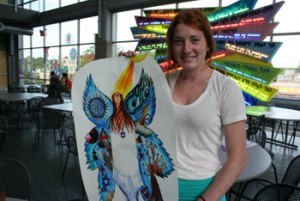
What are the implications of housing the SAR school Torah scroll in the Torah ark created by Siona in a very Indian-influenced style? How can/does art blend cultures? Refuse to mix cultures? What does it mean when elements of various religious cultures are mixed and blended?
Siona’s life and work demonstrate the reality that one person can be many things at one time and participate in multiple cultures at once. In Siona’s case, she is Jewish, Indian, a woman, an artist, and so on. How do the students words and artwork reflect this same reality in their own lives?
The Vision of Ezekiel
from Ezekiel, Chapter 1
In the thirtieth year, on the fifth day of the fourth month, when I was in the community of exiles by the Chebar Canal, the heavens opened and I saw visions of God.
I looked, and lo, a stormy wind came sweeping out of the north — a huge cloud and flashing fire, surrounded by a radiance; and in the center of it, in the center of the fire, a gleam as of amber. In the center of it were also the figures of four creatures. And this was their appearance:
They had the figures of human beings. However, each had four faces, and each had four wings; the legs of each were [fused into] a single rigid leg, and the feet of each were like a single calf’s hoof; and their sparkle was like the luster of burnished bronze. They had human hands below their wings. The four of them had their faces and their wings on their four sides. Each one’s wings touched those of the other. They did not turn when they moved; each could move in the direction of any of its faces.
Each of them had a human face [at the front]; each of the four had the face of a lion on the right; each of the four had the face of an ox on the left; and each of the four had the face of an eagle [at the back]. Such were their faces. As for their wings, they were separated: above, each had two touching those of the others, while the other two covered its body. And each could move in the direction of any of its faces; they went wherever the spirit impelled them to go, without turning when they moved.
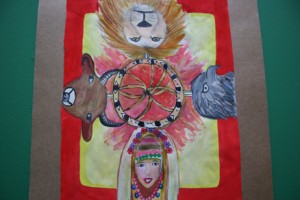
Such then was the appearance of the creatures. With them was something that looked like burning coals of fire. This fire, suggestive of torches, kept moving about among the creatures; the fire had a radiance, and lightning issued from the fire. Dashing to and fro [among] the creatures was something that looked like flares.
As I gazed on the creatures, I saw one wheel on the ground next to each of the four-faced creatures. As for the appearance and structure of the wheels, they gleamed like beryl. All four had the same form; the appearance and structure of each was as of two wheels cutting through each other. And when they moved, each could move in the direction of any of its four quarters; they did not veer when they moved. Their rims were tall and frightening, for the rims of all four were covered all over with eyes. And when the creatures moved forward, the wheels moved at their sides; and when the creatures were born above the earth, the wheels were born too. Wherever the spirit impelled them to go, they went — wherever the spirit impelled them — and the wheels were born alongside them; for the spirit of the creatures was in the wheels. When those moved, these moved; and when those stood still, these stood still; and when those were born above the earth, the wheels were born alongside them — for the spirit of the creatures was in the wheels.
Above the heads of the creatures was a form: an expanse, with an awe-inspiring gleam as of crystal, was spread out above their heads. Under the expanse, each one had one pair of wings extended toward those of the others; and each had another paid covering its body. When they moved, I could hear the sound of their wings like the sound of mighty waters, like the sound of Shaddai, a tumult like the din of an army. When they stood still, they would let their wings droop. From above the expanse over their heads came a sound. When they stood still, they would let their wings droop.
Above the expanse over their heads was the semblance of a throne, in appearance like sapphire; and on top, upon this semblance of a throne, there was the semblance of a human form. From what appeared as his loins up, I saw a gleam as of amber — what looked like a fire encased in a frame; and from what appeared as his loins down, I saw what looked like fire. There was a radiance all about him. Like the appearance of the bow which shines in the clouds on a day of rain, such was the appearance of the surrounding radiance. That was the appearance of the semblance of the Presence of the Lord. When I beheld it, I flunk myself down on my face. And I heard the voice of someone speaking …
From:
Jewish Publication Society. Tanakh: A New Translation of the Holy Scriptures According to the Traditional Hebrew Text. 1st ed. Philadelphia: Jewish Publication Society, 1985, pp. 893-894.
Feature image by Sonia Narang. Artist Siona Benjamin creates a “Torah Ark” a departing gift to the SAR Academy.

